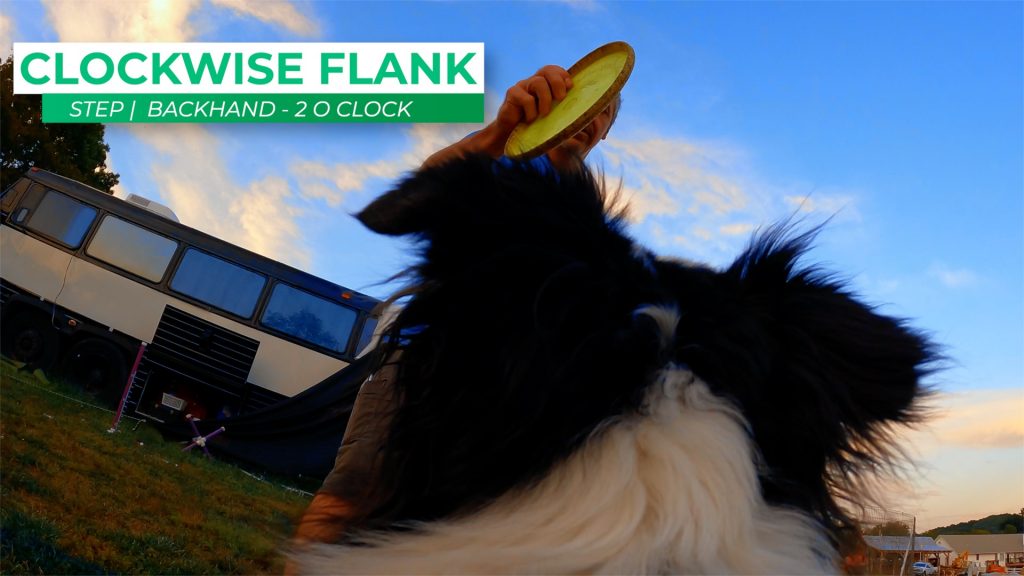
DaEppieCam | Applied Disc Quan Do Flatwork Compass Form: Canine POV
I needed to test out DaEppieCam, a GoPro Hero 9 so we went with the Flatwork Compass The Flatwork Compass is a disc dog form that separates the Flank from the Pass, creates a reliable trigger, and exposes the team to all of the key elements of Team Movement. https://www.youtube.com/watch?v=xW7Czz-7ows&list=PL8zWXaJfi1-synGOkBJ7u4p-WkotsL3LR... More, a Yellow Belt Disc Quan Do Form, a core principle and one of the Holy Trinity of Disc Quan Do forms. We were set up too close to the bus, and I was trying to actually frame some shots for learning purposes, so the form was done with tiny little passes and tiny little flanks. I tried to keep Eppie honest, give him some clear communication, and set up rather challenging short leaping throws on the run.
The Flatwork Compass is a disc dog form that separates the Flank from the Pass, creates a reliable trigger, and exposes the team to all of the key elements of Team Movement. https://www.youtube.com/watch?v=xW7Czz-7ows&list=PL8zWXaJfi1-synGOkBJ7u4p-WkotsL3LR... More, a Yellow Belt Disc Quan Do Form, a core principle and one of the Holy Trinity of Disc Quan Do forms. We were set up too close to the bus, and I was trying to actually frame some shots for learning purposes, so the form was done with tiny little passes and tiny little flanks. I tried to keep Eppie honest, give him some clear communication, and set up rather challenging short leaping throws on the run.
Slow Motion 50%
The video turned out pretty solid, I think. Pretty excited about using a bit more EppieCam footage, I know these featured Dog’s eye perspective things can be hard to watch, but the perspective is a really nice addition when it comes to communicating some of these handling and training concepts.
Flatwork Compass
This Disc Quan Do form is highly useful. This is kind of a warmup situation and small area field test. I was worried about the camera and wound up in the wrong position on the field. I went with it. I tried to make tiny little passing throws that were legitimately thrown by the handler and read and responded to by the dog.
This short game of play puts great stress and emphasis on triggers. It also develops the ability to connect at a distance and work the dog on the way in. Done well, this will increase the dog’s ability to read communication, enhance the ability of the handler to communicate direction and intent, and will put that communication to the test and ask the team to function efficiently together.
Same Video Live Speed with Instant Replay
Blocking and Stopping the Dog
Notice all the blocking that is happening within the play. Also note that these blocking maneuvers are just simple stance shifts and poses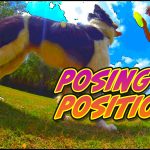 Posing is a communication tool for throwing discs to dogs (or people). A pose is a frozen moment of a throw; a key moment of the backswing perhaps, or a flashy presentation of... More that play on Pressure
Posing is a communication tool for throwing discs to dogs (or people). A pose is a frozen moment of a throw; a key moment of the backswing perhaps, or a flashy presentation of... More that play on Pressure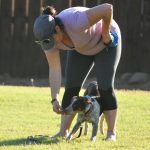 Pressure comes in many forms in dog training. Positional Pressure, Performance Pressure, Environmental Pressure, the Plane of the handler’s body. Pressure is a fact. How you wield it or leverage it is up... More. Pushing towards the dog slows the dog down, pulling away from the dog speeds her up. Choose the time you want to slow the dog down and engage with a pushing stance shift or draw the dog in sharply by pulling. At some point in time you are going to need to stop. That is what blocking is for.
Pressure comes in many forms in dog training. Positional Pressure, Performance Pressure, Environmental Pressure, the Plane of the handler’s body. Pressure is a fact. How you wield it or leverage it is up... More. Pushing towards the dog slows the dog down, pulling away from the dog speeds her up. Choose the time you want to slow the dog down and engage with a pushing stance shift or draw the dog in sharply by pulling. At some point in time you are going to need to stop. That is what blocking is for.

Note your dog’s direction. Eppie wants to move clockwise here but I am pushing against him with my right leg, applying pressure to my left in the counter clock direction. This blocking concept is a key communication and handling technique. Just move your leg to the outside of your dog’s line to grab them and stop them from going in that direction.
This blocking movement and concept are key to moving and working together as a team. They are also the keys to connection, changing lines, and handling your disc dog. The physical movements and the rudimentary, base level concepts of the blocking movement can be enhanced and developed in the Solo Stance Shifting form. Fluency of the Stance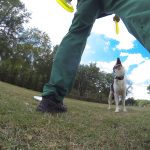 The handler's stance is important. There are many ways to stand and each way you stand can say a different thing. Stances communicate pressure and direction. Switching stances sends information to the dog. More Shifting forms is required for smooth Flatwork
The handler's stance is important. There are many ways to stand and each way you stand can say a different thing. Stances communicate pressure and direction. Switching stances sends information to the dog. More Shifting forms is required for smooth Flatwork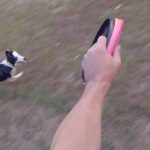 Flatwork is the stuff that happens between the catches. How the team moves and transitions, often without the disc, is flatwork. Flatwork concepts in disc dog are taken from the agility and herding... More, Shapes and transitional play.
Flatwork is the stuff that happens between the catches. How the team moves and transitions, often without the disc, is flatwork. Flatwork concepts in disc dog are taken from the agility and herding... More, Shapes and transitional play.
Communicate and Execute the Flanks
Following the pattern of clock then counter clock, the Flatwork Compass starts with two flanking throws one clock, then 1 counter clock.
The Law of Resonant Spins is followed and the clock flanks are Backhands and the counter clock flanks are SideArms or Overhand Wrist Flips – take your pick…

2 O Clock with a Backhand 
10 O Clock with a SideArm
Passing – Keep Space in Mind
The next two moves in the Flatwork Compass are a clockwise and counter clockwise Pass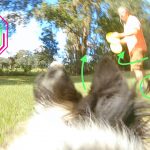 A Pass or Passing is a linear Team Movement maneuver that has the dog running or moving past the handler in close proximity, crossing or breaking the plane of the handler's body.. A Pass has the dog running directly past the handler. The dog crosses the plane of the handler from front to back, back to front, or side to side.
A Pass or Passing is a linear Team Movement maneuver that has the dog running or moving past the handler in close proximity, crossing or breaking the plane of the handler's body.. A Pass has the dog running directly past the handler. The dog crosses the plane of the handler from front to back, back to front, or side to side.

5-6 O Clock Backhand 
6-7 O Clock SideArm
Tightening Up – Communication, Disc Handling, Triggers, and Space
Doing the form at this distance tightens up your game quite a bit. The reduction of space places the emphasis on timely and thoughtful communication and challenges handler control. It asks you to handle the dog at all times by reducing the read time available and forces the handler to have flawless disc management to emphasize and clarify the communication.

Often you are doing two or three things at once. When that’s the case, it helps to have some of those skills on autopilot so you don’t have to put any mental bandwidth towards them and can remain more present for making the throw, communicating with, and reading the dog.
You won’t have any physical issues like dropping discs, standing around, or being unpurposefully out of position if you have done the Stance Shifting form and the 4 Hands form. Every single base level skill used here is exercised and applied in those two forms.
If you are a practitioner of Disc Quan Do you will have trained for these trials; loading discs, establishing position, and posing should be running on autopilot. You can let that stuff go and focus on reading the dog and delivering a great throw. Boom POW!





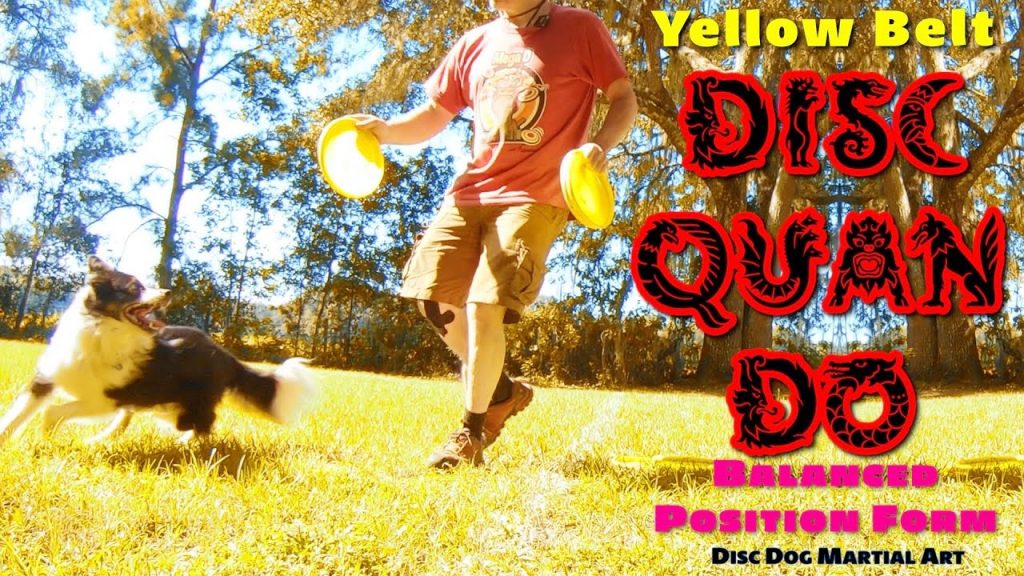
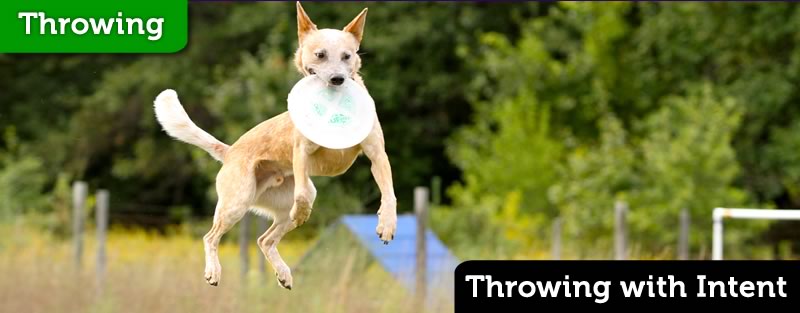
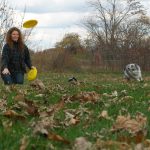

HI Ron, you’d notes that I should also consider checking out the forehand throw. Can you guide me where to find it? Thanks, Susan & Orbs
This is useful: https://pvybe.com/discdogger-weekly-season-3/throwing-rollers-sidearm-backhand/
And I think the 4 Hands Form is covered here: https://pvybe.com/disc-dog-training/on-throwing/better-disc-throwing-intangibles-with-the-4-hands-form/
oh hahaha 4-hands form not forehand throw got it. thanks.
Wow, camera work is amazing!
It’s a totally Epic mobile camera platform, for sure. Eppie does good work.